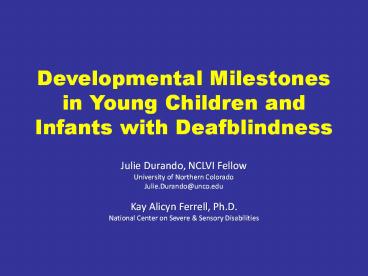Developmental Milestones in Young Children and Infants with Deafblindness - PowerPoint PPT Presentation
Title:
Developmental Milestones in Young Children and Infants with Deafblindness
Description:
Project PRISM A National Collaborative Study on the Early Development of Children with Visual ... Child s Visual Diagnosis Cortical visual impairment = 8 ... – PowerPoint PPT presentation
Number of Views:330
Avg rating:3.0/5.0
Title: Developmental Milestones in Young Children and Infants with Deafblindness
1
Developmental Milestones in Young Children and
Infants with Deafblindness
- Julie Durando, NCLVI Fellow
- University of Northern Colorado
- Julie.Durando_at_unco.edu
- Kay Alicyn Ferrell, Ph.D.
- National Center on Severe Sensory Disabilities
2
Objectives
- 1). To share quantitative data on the
achievement of developmental milestones in
infants and children who are deafblind, and - 2). To discuss the implications of the findings
for early intervention and educational planning
for young children who are deafblind.
3
Project PRISMA National Collaborative Study on
the Early Development of Children with Visual
Impairments
4
Collaborating Agencies
- Anchor Center for Blind Children
- Blind Childrens Center
- Dallas Services for Visually Impaired Children
- The Foundation for Blind Children
- New Mexico School for the Visually Handicapped
Preschool - Visually Impaired Preschool Services
5
Laurie Hudson
Earl Palmer
Tom Miller
Mirna Pineda
Debbie
Gleason
Mary Ellen
McCann
Pam Crane
Marion Yoshida
Donald P. Bailey
David Warren
Sally J.
Deitz
Lynne Webber
Prism People
Deborah
Hatton
J Greeley
Jim
Warnke
Allen Huang
Corinne
Kirchner
Janis
Mountford
Verna Hart
Sharon
Bensinger
Madeline
Milian
Marianne Riggio
Terry
Goldfarb
Chris Tompkins
Bill Muir
Stuart Teplin
Suze Staugus
Amy Murphy
Richard Gibboney
Schel Nietenhoefer
Kelly
Parrish
John
Jostad
Diane
Pena
Carol
Danielson
Rose Shaw
Fran
Black
Tina
Sustaeta
Carol King
Beth Teeters
Betty
Dominguez
Brenda Hoy
Kathy Tompkins
Dean Tuttle
Patrika Griego
Patti Watts
Jan Nash
Din Tuttle
Dana King
Ann Estensen
Debbie Symington
Sharon Nichols
6
Home States
California
Colorado
Texas
5.4
17.8
11.4
Kentucky
13.4
Arizona
Massachusetts
31.2
6.4
New Mexico
14.4
7
Subject Selection
- New referrals to collaborating agencies
- Less than 12 months CA
- Diagnosed visual impairment, with or without
additional disabilities and/or health conditions
8
Child Measures
- Teller Acuity Cards
- Battelle Developmental Inventory
- Vineland Scales of Adaptive Behavior
- Temperament Scales
- Milani-Comparetti Motor Development Screening
Test - ABILITIES Index
- Medical and health questionnaires
9
Family Measures
- Demographic information
- Parenting Stress Index
- Family Resource Scale
- Home Observation and Measurement of the
Environment (HOME)
10
Service Measures
- Amount, type, and extent of special education and
related services - Parent satisfaction with services
- Primary interventionists perception of Familys
participation in services
11
Assessment Protocol
- At referral
- 4 months
- 8 months
- 12, 18, 24, 36, 48 months
- Project evaluators assess children
- Parents complete packets and submit directly to
PRISM
12
Training of Project Evaluators
New Evaluators Returning Evaluators Total
New York 1992 9 9
Boulder 1992 8 7 15
Phoenix 1994 4 15 19
Louisville 1995 2 18 20
Denver 1996 19 19
13
Number of Assessments
Total Mean per Child Percent of Possibilities
Battelle 569 2.82 88.2
HOME 544 2.69 84.3
Milani 248 1.23 56.1
Teller 543 2.68 84.2
Vineland 542 2.68 84.0
14
BDI Age Scoresby Additional Disability
15
Project Prism Final Report
- http//www.unco.edu/ncssd/research/PRISM/default.h
tml
16
Children with DeafblindnessAge of Entry
- Mean 8.60 months
- Standard Deviation 2.33 months
- Youngest at entry 3 months
- Oldest at entry 12 months
- N 25
17
Ethnicity of Children with Deafblindness (n25)
18
Childs Visual Diagnosis
- Cortical visual impairment 8
- Optic nerve hypoplasia 3
- Retinopathy of prematurity 2
- Colobomas 2
- Glaucoma 1
- Myopia 1
- Optic atrophy 1
- Cataracts 1
- Visual diagnosis not known 6
19
Severity of Additional Impairments
20
Developmental Milestones
- Reaches for and touches object
- Generally follows directions related to daily
routine - Transfers object from hand to hand
- Removes simple garment without assistance
- Sits alone without support 5 seconds
- Walks without support 10 feet
- Produces 1 or more C-V sounds
21
Developmental Milestones (Continued)
- Copies circle
- Plays peek-a-boo
- Uses pronouns I, you, me
- Moves 3 or more feet by crawling
- Walks down stairs alternating feet
- Feeds self bite-size pieces of food
22
Developmental Milestones (Continued)
- Uses 2-word utterances to express meaningful
relationships - Searches for a removed object
- Repeats two-digit sequences
- Points to at least one major body part when asked
- Controls bowel movements regularly
23
Demonstration of Milestones
24
Sequence Transfer Object Hand to Hand was
Demonstrated (n 11)
25
Sequence Feeds Self Pieces of Food was
Demonstrated (n 7)
26
Percentage Demonstrating Milestone
27
Percentage Demonstrating Milestone
28
Percentage Demonstrating Milestone
29
Implications
- Development for children with deafblindness is
especially unique - Holistic, multi-disciplinary approach to
assessments, programming and intervention - Use caution when interpreting assessments
30
Factors in Development
- Degree of functional vision
- Amount of hearing
- Additional Impairments
- Age of onset of each impairment
- Intervention
- Environment
31
Holistic, Multidisciplinary Approach
- Areas of development are inter-related
- Team includes parents and professionals,
including persons trained in sensory impairments - Consider factors and their impact on development
32
Interpret Assessments with Caution
- Know limitations of standardized assessments
- Norms usually do not include children with
deafblindness - Modifications or excluding items
- Does protocol allow child to demonstrate
abilities? - Guiding intervention
- Consider a different approach to intervention if
development seems stalled
33
Acknowledgements
- Project PRISM was supported by CFDA 84.0203C
Field-Initiated Research H023C10188 - Julie Durando is a National Center for Leadership
in Visual Impairment (NCLVI) Fellow supported by
the NCLVI and OSEP Cooperative Agreement
H325U040001

